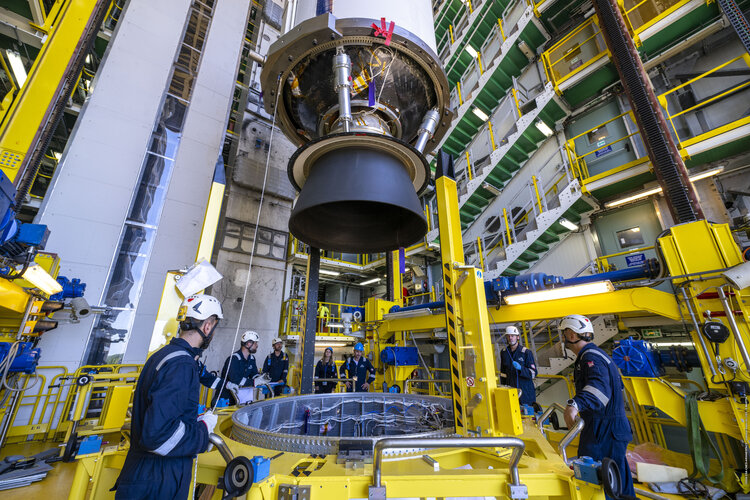EarthDaily buys analytics specialist amid imagery constellation deployment delay
Tuesday, 15 October 2024 10:00

Ciseres: AI-powered satellites for rapid disaster response
Tuesday, 15 October 2024 09:50
This week, at the International Aeronautics Congress in Milan, ESA officially kicked off a new project called Ciseres, a small satellite mission designed to significantly improve crisis response times using artificial intelligence (AI). Part of ESA's Civil Security from Space (CSS) programme, Ciseres aims to enhance satellite capabilities to alert first responders and government officials within minutes of the occurrence of a disaster – such as floods, fires, landslides. The project is led and co-financed by Deimos, a European space tech company specialising in small satellite missions.
ESA's Moonlight programme: Pioneering the path for lunar exploration
Tuesday, 15 October 2024 08:58
Imagine a near future where services such as satellite navigation, video conferencing, and file sharing are as seamless on the Moon as they are on Earth.
OroraTech raises 25 million euros for satellite wildfire detection system
Tuesday, 15 October 2024 08:54

Revolutionising crisis response in Europe with Safeplace
Tuesday, 15 October 2024 08:30
In an era where natural disasters and emergencies are becoming increasingly frequent and severe, ESA is taking a significant step forward in enhancing Europe's crisis management capabilities.
Contract secures build for ESA’s Harmony mission
Tuesday, 15 October 2024 08:25
ESA has awarded a contract valued at over €280 million to OHB in Germany to build ESA’s two Harmony Earth Explorer satellites.
This innovative research mission will provide valuable new data on various Earth processes, from shifts in the shape of the land surface caused by earthquakes and volcanic activity to insights into glacier movement. Additionally, it will enhance our understanding of the interactions between the upper ocean and lower atmosphere, all of which will contribute to a deeper comprehension of Earth's dynamic systems.
China unveils its plans to turn its feats in space exploration into scientific advances
Tuesday, 15 October 2024 07:17This request seems a bit unusual, so we just need to confirm you're human. Please complete the slider CAPTCHA by dragging it to the right. Thank you for your understanding!
If you believe this is an error, please contact our support team.
185.132.36.159 : 5ef222fb-1de7-425f-a034-3965ceff
A Southern California school plants a 'Moon Tree' grown with seeds flown in space
Tuesday, 15 October 2024 07:17This request seems a bit unusual, so we just need to confirm you're human. Please complete the slider CAPTCHA by dragging it to the right. Thank you for your understanding!
If you believe this is an error, please contact our support team.
185.132.36.159 : 1c599e5e-1e53-4b83-b24f-9ab791f6
Comet C/2023 A3 brightens SOHO’s week
Tuesday, 15 October 2024 06:00 Video:
00:00:23
Video:
00:00:23
From 7 until 13 October 2024, ESA/NASA’s SOHO spacecraft recorded Comet C/2023 A3 (Tsuchinshan–ATLAS), the second brightest comet it has ever seen. Meanwhile, large amounts of material were being spewed out by the Sun (covered in the centre), and planet Mercury is visible to the left.
The comet’s nucleus is clearly visible, surrounded by a dusty coma and trailing an impressively long tail. SOHO sees the large dust tail edge-on, curving in on itself as it is pushed outward by solar wind.
At the end of the video you can also see a rare phenomenon known as an ‘
NASA probe Europa Clipper lifts off for Jupiter's icy moon
Tuesday, 15 October 2024 03:21 NASA probe Europa Clipper lifted off from the US Kennedy Space Center on Monday, bound for an icy moon of Jupiter to discover whether it has the ingredients to support life.
Lift-off took place aboard SpaceX's powerful Falcon Heavy rocket. The probe is set to reach Europa, one of Jupiter's many moons, in five and a half years.
The mission will allow the US space agency to uncover new det
NASA probe Europa Clipper lifted off from the US Kennedy Space Center on Monday, bound for an icy moon of Jupiter to discover whether it has the ingredients to support life.
Lift-off took place aboard SpaceX's powerful Falcon Heavy rocket. The probe is set to reach Europa, one of Jupiter's many moons, in five and a half years.
The mission will allow the US space agency to uncover new det 








